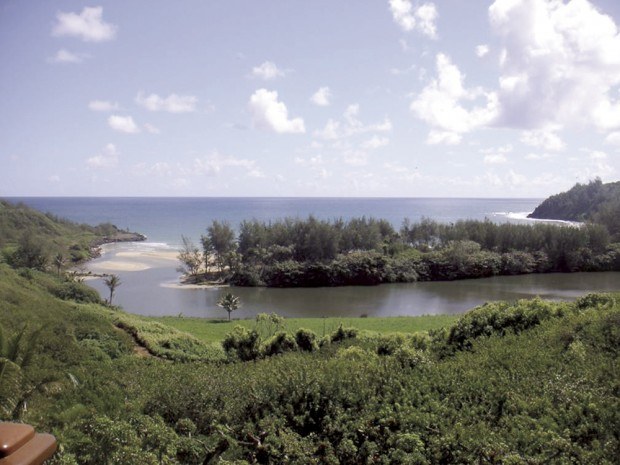KILAUEA — Concerned residents are saying they will keep a vigilant watch on what is being called an illegal, deliberate and systematic removal of trees at the beach known as Rock Quarry.
Also known as Kahili Beach after the name of a quarry that used to operate west of the beach, and as Waiakalua, its proper name, the secluded spot on Kaua‘i’s northeastern coast is hidden by a water inlet and a grove of trees. For the past few years those trees have been cut down or poisoned, according to the Hawaiian Islands Land Trust, which owns 5.4 acres on the beach.
“A community member called us when she smelled diesel fuel,” said Jennifer Luck, the Kaua‘i Island director of the Trust.
Luck and Bill Chase, vice president of the Trust, presented the issue Tuesday night to the Kilauea Neighborhood Association. The two organizations collaborate on beach cleanups and other projects.
Also called the Hawaiian Ironwood, the tree they talked about is considered an invasive species that makes it difficult for other plants and trees to grow in the area. The tree can reach 100 feet and thrives in sand and near salt water.
Luck said she does not know the reason someone or some group is taking out the trees, but suspects clearing an ocean view is to blame, rather than eliminating an invasive tree.
“The trees block the view of the ocean if you live across from the area,” Luck said. “It is a possibility that someone across the way wants a better view of the ocean, and that is the only motive I can think of at this point.”
If the trees disappear, Luck said the park would open up to the land side and lose its appeal as a rare, secluded spot of natural wilderness.
“It is changing and has opened up,” Luck said. “It is not so private any more, and that is wrong.”
By reviewing photographs taken from her home on the hill above the beach, Elizabeth Freeman of Kilauea said she could see that the tree line was thinning and informed Luck.
From 2005 until 2011, a single sand dune was the only exposed area of the beach from behind the tree line, she said. The 2012 photos show several ironwoods and other species, including false kamani, either missing or dying out.
At close observation, Freeman and Luck noticed that missing trees did not suffer from disease or storm blow-down. The stumps have the clean cut of a chainsaw, and diesel fuel was poured on other trees to kill them off more slowly, they said.
Chase said the tree loss is gradual, but that the pace has picked up in recent months. A police report was made, and the groups have established a reward to encourage people to come forward with what they know.
“Somebody is systematically thinning out that spit,” Chase said at the meeting.
County Planning Director Mike Dahilig attended the meeting and told residents his office would schedule an inspection of the trees. The Trust asked the Kilauea community to keep an eye out for suspicious activity and to call the police or the Trust with information.
The reward is to solicit information, Chase said.
The short-term plan is to stop the tree killing and environmental poisoning, Chase said. The long-term remedy is a complete restoration of trees, including ironwoods ,and the re-introduction of more native species, he added.
“The idea is that they put them down, and we are putting them back up,” Chase said. “We are asking for help and continued vigilance.”
The Trust also collaborates with the Hawai‘i Department of Land and Natural Resources on projects. Deborah Ward, a DLNR spokeswoman, said the agency is looking into the ironwood tree matter.
Kahili Beach is adjacent to the Kilauea Point National Wildlife Refuge. Through donated fee ownership from Louise and Monte Zweben, the property safeguards the shoreline ecosystem. It remains open to the public and is a popular spot for families, but the 5.4-acre stretch is considered privately owned and does not honor county camping permits.
Call 755-5707 or email thjennifer@hilt.org for more information about the disappearing trees. Visit www.hilt.org to find out more about Kahili Beach.
• Tom LaVenture, staff writer, can be reached at 245-3681 (ext. 224) or tlaventure@thegardenisland.com.






